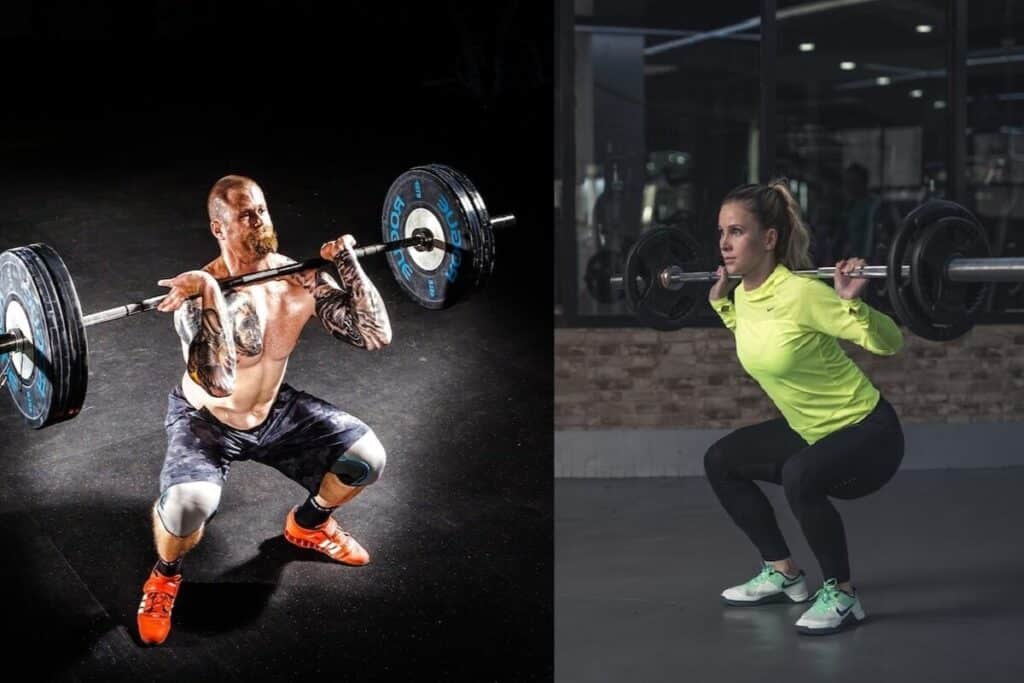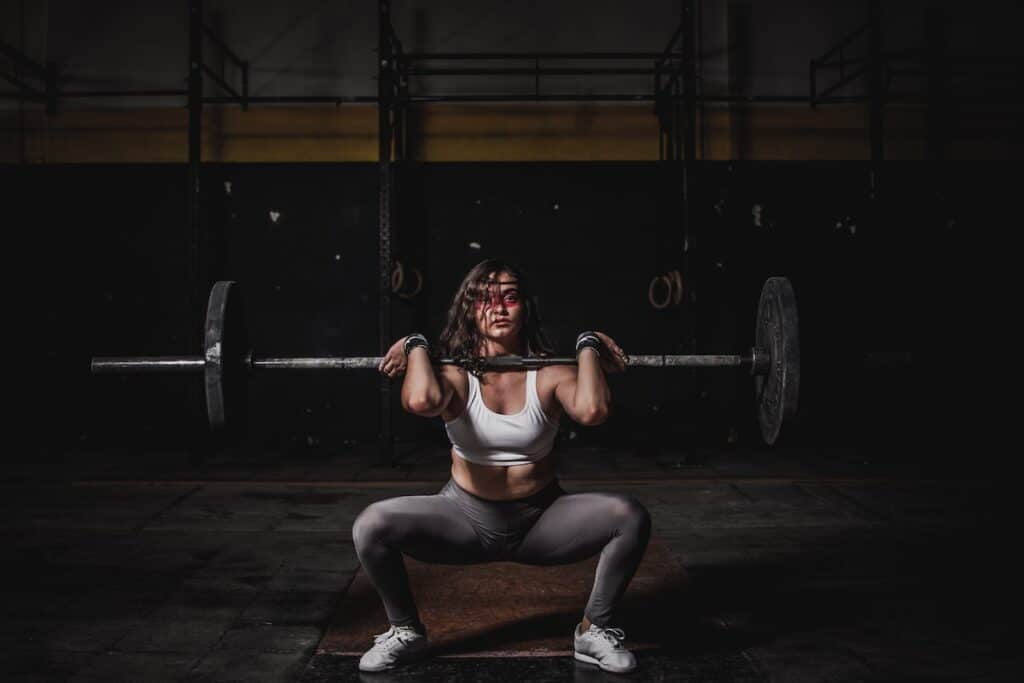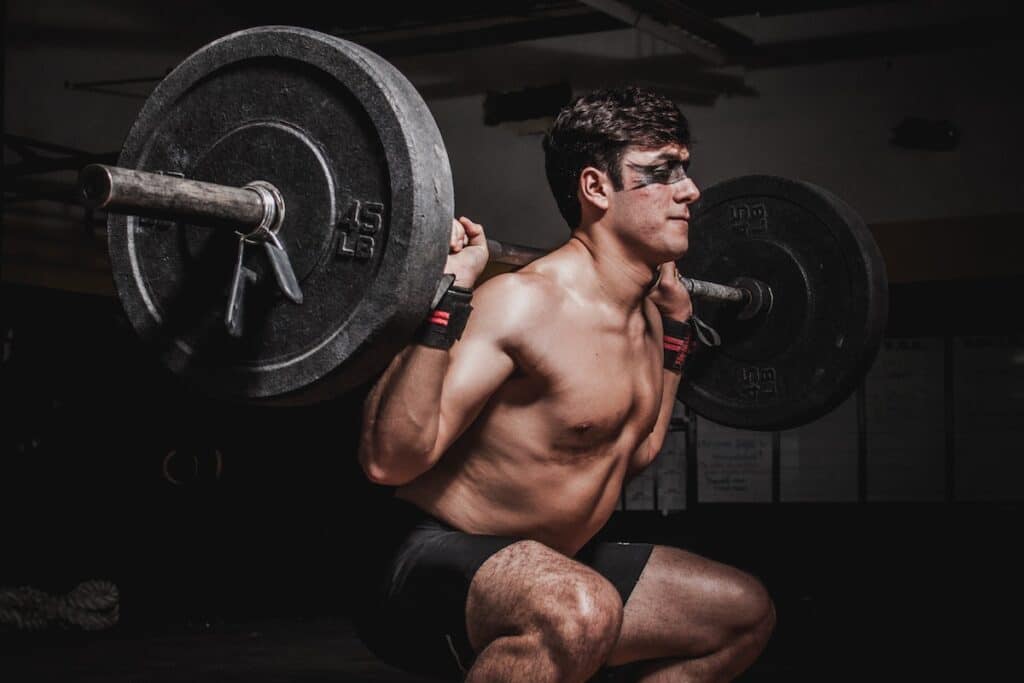Squats are one of the most beneficial exercises for strengthening your lower body. As the saying goes, “If it’s worth doing, it’s worth doing right.” You’ve probably heard of the two main types of squats – front squats and back squats – but how do they compare?
In this article
Both exercises involve squatting down and then standing up, but there are a few key differences between the front squat vs the back squat that can make a big difference in your workout.
Let’s take a look at their respective benefits, technique, form tips, and differences between the two movements to help you decide which variation is best suited for you.
What are front squats and back squats?
The front squat involves holding a weight across your chest while you squat, typically with your hands gripping it or using an Olympic barbell. The back squat involves placing the weight on your shoulders behind your neck while you squat. This can be done either with dumbbells or with an Olympic barbell.

Both exercises work to strengthen your legs, glutes, hamstrings, core muscles, and lower back. For the most part, they both use similar motion patterns that help to improve posture and balance; however, there are some subtle differences in how each exercise works different muscle groups.
Front squats tend to hit more quads than back squats because they require more upright posture and knee flexion than back squats do. Additionally, because of its positioning across the chest during the movement, front squats provide additional tension for upper body muscles like the lats and traps which helps increase overall strength levels for these areas too.
Benefits of Front Squats
Front squats can offer numerous physical benefits. These include increased core strength, improved balance, and stability, and increased quadriceps size and strength. You’ll be able to build a stronger core by leaning forward during the squat motion and engaging your abdominal muscles more deeply than in traditional back squats.
Additionally, using a narrow stance while squatting with weight on your front shoulders will work on improving your balance and coordination. Finally, front squats are great for targeting the quadriceps, which is more prominent than the hamstrings in back squats, for greater size and strength.
Increased Core Strength
Both front and back squats can increase core strength, but they do so in different ways. Front squats require the lifter to keep their torso upright throughout the entire movement, engaging the core muscles to maintain balance and prevent excessive forward lean.
This focus on posture helps strengthen deep abdominal muscles that are commonly underutilized during other exercises.

Additionally, when performed with proper form, front squats heavily engage the erector spinae (or lower back) muscles which stabilize the spine against a heavy load and promote better posture overall. On the other hand, back squats allow for more weight to be lifted which increases muscular tension on almost every joint in the body; this increased tension is what leads to greater strength gains.
Because of its heavy load capacity, back squats also require significantly lower body stability from both your hip and ankle joints; this creates an increased demand for core activation which helps increase the strength and endurance of your trunk musculature over time.
As such, both front and back squats have unique benefits when it comes to increasing core strength. To further improve balance and stability, however…
Improved Balance and Stability
To further improve balance and stability, incorporating exercises such as lunges and single-leg squats can be beneficial. Squatting with a barbell – either front or back squat – provides an additional challenge that strengthens both the core and the legs. The table below shows some of the differences between the front vs the back squat:
| Front Squats | Back Squats | |
|---|---|---|
| Range of motion (ROM) | Limited ROM due to chest position | Greater ROM due to upright torso position |
| Core Strength Focus | Increased recruitment of abdominal musculature for stabilization during eccentric phase. | Mainly relies on lumbopelvic-hip complex for stabilization during lift. |
| Quadriceps focus | Greater quadriceps activation with increased knee flexion.Greater emphasis on hip extension with less knee flexion. |
Both exercises will help in improving balance and stability, but depending on your goals, one exercise may be more suitable than the other. For instance, if you are looking to increase muscle size in your quads, then back squats would probably be more effective compared to front squats.
Furthermore, if you want to target abdominal muscles for greater core strength then front squats could be a better choice than back squats due to their limited range of motion which requires more stabilization from abdominal musculature during the eccentric phase of movement.
With that said, transitioning into the subsequent section about ‘increased quadricep size and strength’ should not be difficult as both exercises can help achieve this goal depending on which variation you choose.
Increased Quadricep Size and Strength
Elevating your quadricep strength and size through exercises like squats can be a powerful way to improve your physique – a feat as mighty as lifting mountains! The two major types of squat exercises are the front squat and the back squat, each with its own set of benefits.
With regard to increasing quadricep size and strength, both variations offer great results; however, front squats have an edge over back squats in this regard because they place more emphasis on engaging the quads.
Here are four ways that front squats help build bigger and stronger quads:
- Front squats require you to keep your torso upright throughout the exercise, which engages your quads more than a back squat.
- You must keep your elbows high when performing a front squat, resulting in an increased range of motion for the quads.
- The weight is evenly distributed between your legs when doing a front squat compared to how it’s placed primarily on one side during a back squat.
- When executing a front squat correctly, you’ll feel greater tension in your quads due to the increased recruitment of muscle fibers from the added stability needed for balance in maintaining an upright position while lifting heavy weights.
These factors make it clear why front squats should be included as part of any leg workout routine if you’re looking to increase quadriceps size and strength quickly and effectively. However, there are still many benefits that come with doing back squats too, which we’ll explore next!
Benefits of Back Squats
You’ll reap the rewards of back squats, with their ability to increase lower body strength and power. Not only do they help build muscle mass in the glutes, hamstrings, and quads, but they also help improve core stability by engaging your entire abdominal wall.
You can also use back squats to strengthen your hip extensors while improving balance and coordination as well as posture. When done correctly, back squats provide a great workout for not just the legs but also the lower back muscles.
Back squats are an important exercise for athletes who need explosive power from their legs such as sprinters or other track athletes. The deep knee bend that is involved in this movement effectively strengthens the leg muscles used for running which helps to improve speed and agility on the field or track.

Additionally, because of the increased range of motion, it provides compared to front squats, you can place more emphasis on certain parts of your legs like your hips during back squats.
The benefits go beyond physical performance though; when done correctly, back squats can have a positive mental effect too. Squatting deeply with proper technique requires focus and concentration which leads to greater mental resilience when facing difficult challenges both on and off the playing field.
This improved focus combined with improved physical abilities makes them an invaluable exercise for any athlete’s training regimen. With practice, you’ll be able to unlock these benefits without sacrificing form or safety – transitioning into learning about technique and form in subsequent sections will set you up for success!
Comparing the Two Squats: Front Squat vs Back Squat
When it comes to choosing between a front squat vs a back squat, it really depends on what kind of goals you have set for yourself as well as what type of equipment is available to you at the time.
Front squats may be slightly easier to learn due to their simpler technique compared to back squats so if you’re new to strength training this could be a good option for building confidence in proper form before moving onto heavier weights or other variations of squatting technique.
On the other hand, if you want something that will challenge you further then going for a heavier weight with a traditional barbell back squat could be beneficial as well.
Technique and Form
Getting the technique and form of your back squat right can have a huge impact on your performance. To ensure proper execution, follow these steps:
- Start with feet shoulder-width apart
- Ensure you keep your chest up and core engaged throughout the entire lift
- Push through your heels as you descend down and drive through quads to stand back up again
When executing a back squat, it’s important to maintain good posture throughout the entirety of the exercise. You should be in an upright position, with your shoulders pulled back and eyes looking forward. Additionally, keep your core tight to support the spine and prevent any unnecessary arching or rounding of the lower back.
It’s also important to push through the heels when descending into a squat – this will help focus power into glutes and hamstrings rather than compromising movement by overloading other parts of the body.
The most crucial step in perfecting proper form for a back squat is getting comfortable with how it feels in order for you to understand what muscles are being worked during each part of the lift. With this knowledge, you can then adjust accordingly so that all areas are working together efficiently to generate maximum force output.
Frequently Asked Questions
What is the difference in the amount of weight that can be lifted using each type of squat?
You can typically lift more weight when doing a back squat, as it requires less balance and stability compared to a front squat. However, the front squat works your core more, so this is a factor to consider when choosing between front squats vs back squats.
What are the potential risks of performing either type of squat?
Performing any type of squat can cause strain to your muscles and joints. Be sure to warm up properly, use good form, and start with lighter weights before going heavier. Injury is possible if you don’t take the time to learn proper techniques.
Are there any alternative exercises that can be done instead of squats?
Lunges, step-ups, and Bulgarian split squats are great options to work your lower body muscles with less risk. Try them out today for an effective workout!
What muscles are targeted with each type of squat?
You target different muscles with each type of squat. Front squats focus on the quads, glutes, and core, while back squats emphasize the glutes and hamstrings. Both are great exercises for building strength and stability.
Conclusion
Squats are a great way to build strength and improve overall fitness. We’ve compared the front squat vs back squat, and the different benefits they offer.
Front squats target the quadriceps more than the hamstrings, while back squats require more stability and balance. It can be difficult to decide between the two, but understanding their differences and mastering proper form will help you get the most out of each exercise.
In conclusion, depending on your goals, either or both front and back squats can be incredibly beneficial in helping you reach your fitness objectives.
Key Takeaways
- Both front squats and back squats have unique benefits and target different muscle groups.
- Front squats are better for targeting quadricep muscles and increasing core strength and stability.
- Back squats allow for heavier weights and are important for developing explosive leg power and overall lower-body strength.
- Proper technique and form are crucial for both types of squats to prevent injury and maximize results.
